— THE EVOLUTION DECEIT —2 - The "Transitional Form" Who Never LivedIf earth layers and fossil records are inspected, it will be seen that all living organisms have been created instantaneously. The oldest layer of the earth, where fossils of living creatures have been found, is the Cambrian layer which has an estimated age of 500 million years. There are no animal fossils deeper than this layer.Animals belonging to this Cambrian layer have appeared suddenly in the fossil records with no pre-existing ancestors. These animals within the layers possess irreducibly complex organs like eyes, or systems like blood circulation and gills that only emerge in higher organisms.. Also there is no sign in the fossil records that these animals had progenitors. Richard Monstrasky, the editor of Earth Sciences, tells the following about sudden appearance of these living creatures:
The Ever-Missing Links Darwin’s theory of evolution pronounce that species have gradually evolved from each other in a step by step manner by mutations and natural selection. According to this, it takes a very long a time for this gradual development to occur from the simple organism to the complex one. The evident result of this claim is to have strange creatures called "transitional forms" which should have lived in this evolutionary process. For instance, some creatures already having fish characteristics should have possessed some qualities of reptiles by time which would result in the existence of half fish-half reptile creatures in the past. Or there must have been birds, which attained some features of reptiles with progression of time. Since evolutionists claim all animals have come into existence from one another in a step by step process, there must be millions of these transitional forms in quantity and variety. If such animals had really existed, their remains must have been present in the fossil records. Moreover, the number of transitional forms should have been even greater than present animal species and their remains must have covered all parts of the world. In addition, evolutionists have been researching in order to find the fossils of these transitional links since 19th century. Yet, there is not even a sign of these forms looked for with such
devotion. As a result of the research made for one and a half century,
there is not even one fossil belonging to a transitional form. This is
the point where the greatest crisis of evolution occurs. In spite of the
impossibility, the evolutionist scientists never give up their blind
dedication to the theory. They always live with the expectation that one
day the theory will be validated with the discovery of a transitional
forms. They believe even if this generation fails to achieve the
expected outcome, the scientists of the next generation will succeed the
pursuit.
Stating that complex organs such as lungs, eyes and ears developed with small modifications in a gradualist evolution, would mean that the transitional forms also had some parts of these organs. Then, there must have been animals with partially developed eyes or lungs. Unfortunately, fossils of such animals could never be found. Therefore, Darwin’s colleague T.H. Huxley warned him especially that he had to rearrange his theory for letting in rapid, large-scale changes. Despite his warnings, Darwin did not change his mind. (He believed that accepting the random occurrence of rapid, large scale changes like eyes, would be a more illogical assertion.) According to Darwin, the expected transitional forms would be found in the future. Still, in spite of his hopeful expectancy, he realized that it was the biggest dilemma of his theory. He wrote as such:
Since Darwin, various fossils were presented to public as transitional forms. However, unbiased studies proved that these did not possess the characteristics of transitional forms. As a matter of fact, the most renown one was Archaeopteryx which was not a transitional form between the species of reptiles and birds, but a flying bird with current members of the same species. The horse serial which was the mostly acclaimed example of the transitional forms, was just the arrangement of different animals according to their sizes and number of hooves that lived in different time periods of history. Coelacanth, presented as the evidence of transition from sea to land, is another sample of the inconsistency regarding transitional forms of evolutionists. One of the fish species, Coelacanth was introduced as the ancestor of land creatures by having half fish and half reptile features. Nevertheless, its seizure in oceans during 1930’s meant a great shock for the evolutionists. Thus, Coelacanth was immediately dismissed from the list of transitional forms. In the following pages, we will examine these so-called transitional forms in more detail. Yet, before looking at them more closely, the concept of transitional forms must be studied intimately. Since, evolutionists attempt to include ordinary living creatures into this status by distorting the concept. False Transitional Forms The concept of transitional forms is deliberately misused by the evolutionist researchers. According to the evolutionary theory, for an organism to be named as a transitional form, it must possess halfway completed developed systems. In other words, the organism must have some parts of a developed system, but it must lack some others. A bird with only half of its wings -this type of an animal has never existed- can be an example of a transitional form. However, birds which are not capable of flying like ostriches and penguins, are never shown as transitional forms. These are original and fixed species with fossils dated millions of years, and they are not transitional forms at all.
Since the creature owns characteristics that resemble both reptiles and a mammals, it is depicted as a transitional form of a simple animal. Actually, the facts are not so. Platypus is such a highly developed animal that it even has extraordinary senses. It is furnished with a mechanism which allows it to move with electrical signals since it lives in the mud. In this aspect, it is possible to state that Platypus has a sixth sense in addition to the ordinary five senses of other animals. The electroreceptor system of Platypus is not similar to those that exist in some fish. It is more complex. Platypus forms an electric field with special movements and gives shape to the surface of the river. If today Platypus was extinct and its remnants were found in
fossils records, evolutionists would claim it to be a transitional form
of reptiles to mammals without any hesitation. All of the transitional
forms presented today are the result of such distortions. Impossibility of Transition from Sea to LandAccording to the theory of evolution, life started 3-4.5 billion years ago within the oceans in a "prebiotic soup". The origin of life evolved from proteins to single celled organisms in oceans 2 billion years ago, and it reached its peak point with the evolution of fish which had backbones. According to the story, some the fish inhabiting in waters felt the necessity of passing over to the land and this way, life on lands started.This made up story lacking any concrete evidence is actually in contradiction in many aspects. The question of how the first protein emerged and even before this, how the amino acids that make up the protein came into existence and how they attached to each other in a systematic way, are enough as evidence to refute the theory of evolution. The amino acid and protein structures are so complex that, it is practically impossible for them to occur "by chance". In the chapter named "Refutation of the Molecular Theory of evolution", I am going to examine in detail these impossibilities. But for now, let’s assume that some part of this imaginary story is true and different kinds of fish really developed from the "prebiotic soup" following a gradualist evolution. Actually, only the question of how these sea dwelling organisms passed over to the land, is enough to dispute theory of evolution. In spite of the research and theoretical studies, no satisfying answer is given for these questions, other than some speculative data. As a result of this speculation and distortion, it is said that ancestors of land dwelling animals have left seas 250 million years ago because of scarcity of food supplies and drought. As a matter of fact, there is not even one supportive paleonthological data or experiment to show that this assertion is reliable. The first flaw in the evolutionary supposition occurs in respiration. Living creatures are equipped with various mechanisms that make them mostly suitable for the place of their habitation. There is a common requirement of all organisms for life : Oxygen. Oxygen is an indispensable raw material for living cells, because it is used as supply for burning carbohydrates and energy production. Living things get the oxygen from the environment they live in. The oxygen in water is much less than the oxygen in air. The oxygen that is used up by land dwelling animals is in gas form and about 21% of air is composed of oxygen. A living organism in water is equipped with gills that enable it to use the dissolved oxygen in water. The animals on land, however, use their lungs for the same purpose. Gills and lungs that have totally different structures are two separate mechanisms that assemble oxygen to be useful for the organism’s body. An animal that leaves the water has to make infinite number of changes in its body in order to survive on land. Without these changes, survival on land would be impossible for the animal leaving its sea habitation. For instance, free oxygen in the atmosphere acts like poison for the organisms living in water; however, the contrary is valid for land dwelling animals since oxygen is too limited under water and unusable for respiration. The point where theory of evolution gets stuck is, how animals possessing gills in water transform through mutation and natural selection into animals which can survive on land by respiration through lungs. It is widely known for a very long time that environmental factors do not give rise to evolution. Therefore, mutations and natural selection are the only causes put forward. Yet, it is really impossible to understand the role of mutation and natural selection in helping a fish to develop a very complicated organ like lungs; keeping in mind that the animal can only survive for a few minutes with an "incomplete" lung when trying to pass over to land… Similarly, neo-Darwinist theory of evolution desperately repeats the story that mechanisms like mutation and natural selection are causes for these two separate living systems to evolve from one another. This simply means that, millions of years ago a fish coincidentally acquired a perfect, flawless respiratory system after a series of mutations. At this point, some other questions arise: 1- How did mutations, that occur completely coincidentally and generally with a distortive effect, result in the transition of an already complex system of gills, into another complex and excellent system of lungs? 2- To what extent is the Neo-Darwinist theory of evolution assuming
a gradualist evolution valid at this point? Is it possible for the lungs
to develop gradually in a step by step manner with time? Is it possible
to breathe with a premature, %10 completed lung? There is no answer from the evolutionists regarding these questions. If you look at books like Evolution for Beginners or Introduction to Theory of evolution, we come across with void sentences like "250 million years ago, some fish species passed over to land due to drought and insufficient food resources." Such assertions may always be "supported" with imaginary illustrations showing how a fish transformed into a reptile. In this illustration, fins have transformed into feet. Besides these "scientific" explanations, naturally, there is no answer to the questions listed above. Since, actually there is no way of explanation. In professionally written evolution books, one expects to find detailed explanations about these mechanisms. However, rather than scientific and satisfactory explanations, one comes across with the same type of non-scientific discussions. Senior authorities on theory of evolution say nothing more than, "transition from sea to land occurred somehow, in some unknown manner". The famous evolutionist Maria Geneviev Lavonant has the following comments about evolution:
Moreover, the reason why organisms decided to leave oceans and pass over to land, is again structured on speculations. The two most popular theories on this subject base the emergence of life on land on factors like food scarcity and drought. According to the first theory, scarcity of food sources in oceans led living organisms to land for finding new sources for nutrition. These food sources were, surprisingly, other sea dwelling organisms like invertebrates which had arrived on land even before! Jean Jacques Hublin states the contradictions within the theory and stresses an important issue:
The second theory, on the other hand, reveals more apparent contradictions in comparison with the first one. The contradictions can be clarified with a few basic questions: Does every living organism exposed to drought leave water and seek ways to survive on land? Do the animals today also leave water and transform into land dwelling animals when an ocean dries? Should we commonly not expect these animals to die under normal conditions?
Living Fossil – CoelacanthThe example of Coelacanth has a distinctive place in the history of evolution, since it reveals how evolutionist scientists have always made biased interpretations in evaluating fossils.According to the evolutionists, the first movement which was made with legs was by amphibian like creatures walking on the bottom of shallow waters. For a long time, fish belonging to the Crossopterygian class, among which Coelacanth also exists, have been introduced as a transition form for fish known with walking habits. It is told that the round structure of these fossil’s fins’ performed the function of primitive legs and this organism turned into a tailed water frog (lchthyostega) which is amphibian itself. Anatomic comments about Coelacanths which had only appeared in fossil records then, prevailed until the end of 1930s and met absolute acceptance among the scientists. Furthermore, along with Coelacanth’s primitive way of walking, it was asserted that it had a primitive lung, a developed brain and even a respiratory and digestive system ready to function on land. Coelacanth’s fossil, which had an approximate age of 250 million years was used as concrete transition for transition from water to land. However in December 22nd, 1938 a very interesting discovery was made in Indian Ocean. This incident ended the Coelacanth legend. One of the family members of Coelacanth, thought to have become extinct 70 million years ago, was found alive near Madagascar in 1938 to the astonishment of scientists. The finding of an assumed transitional link alive in oceans, was a great shock for the evolutionists. Evolutionist paleontologist J.L.B. Smith said, if he ever came across with a dinosaur, he would not be more surprised. In the following years, Coelacanth was caught several times in different parts of the world. In 1939 around Chalumnea River and Madagascar shores and in 1952-1953 around Komor Islands; more than forty living Coelacanths were caught.
The examinations indicated that Coelacanth was a fish completely suited for ocean conditions and by no means had any relation with animals on land. Moreover, this fish lived under sea in deep waters. With the discovery of Coelacanth, people knew how far the evolutionists could go in making speculations. Coelacanth had neither a simple lung nor a developed brain as asserted. The structure that was thought to be a primitive lung by evolutionists was nothing but a fatty saccule. Besides, in contrast to what was alleged, the fish did not have a large brain volume, but just a small brain within its large head. The popularity of Coelacanth in the evolutionist publications disappeared suddenly after these facts were disclosed:
However after the revelation of Coelacanth forgery, Michael Denton stated that the evolutionists had to be careful than before :
Yet, this hopeless expectation led some evolutionists to put forward new theories regarding the transition from water to land. Some of them accepted the fish species with lungs as the ancestors of land dwelling animals. This type of fish generally called Dipneuma can use its lungs in addition to its gills. And there are three separate species living in America, Africa and Australia. In fact the thought that these fish evolved into primitive amphibians prevailed since 1850’s. During 1950’s however, they were far from being accepted as transitional forms since they were exceptional samples. At this date, nobody supported the assumption that these were the ancestors of living organisms on land. Maria G. Lavanant explains this situation
In brief, all the so-called transitional forms, alleged to be evidences for transition from water to land, collapsed one by one. Today you can still come across with such references in unprofessional evolutionist publications like high school textbooks or Evolution for Beginners. Yet, this is a classical method used by evolutionists to carry out a methodological disinformation for the readers who have limited knowledge about evolution. At the scientific level, these animals can never be asserted to be transitional forms. Evolutionists are still expecting a great transitional form to appear all of a sudden one day. In the meantime, however, they still try to keep the false evidences on the agenda in order to maintain that the pragmatic evolutionary propaganda is alive. Transition from Land to Water:
The origin of marine mammals is one of the most difficult issues that needs an explanation by the evolutionists. In many sources about evolution, it is asserted that marine mammals whose ancestors were once land dwelling animals, underwent a long evolutionary process to be able to survive in oceans. According to the story, marine mammals followed an opposite transitional way compared to the transition from land to sea. As a result of a second evolutionary process, they returned to waters. However, this theory is not based on any paleonthological evidence and it is completely nonsense. Mammals are accepted to be the most advanced living organisms in the process of evolution. Since this is the case, it is very hard to explain for what reason they returned back to water. The next question is how these mammals adopted to the environment in water better than the any fish. Mammals like dolphins and whales have lungs for respiration, but they have maybe better adaptation to the seas than other fish. It is evident that the imaginary evolution of marine mammals can not be explained by mutations and natural selection. An article published in evolutionist GEO magazine about the evolution of blue whales, conveys the helpless tone of Darwinism about the subject:
This story that is not based on any scientific data also contradicts with all known genetic principles, therefore it is obvious that there may be no logic or essence in this theory. The reason why evolutionists put forward such a story of rapid and sudden mutations, is actually a mere indication of the inadequacy of Darwinist arguments about the subject. Let’s analyze this scenario anyway and see the irrational nature of it in every aspect: When the adaptations that a marine mammal with lungs has to undergo
for respiration are considered, the word "impossible" remains
inadequate. During the occurrence of such a transition, the
non-existence of just one stage in the evolution process would actually
end the whole process and result in the death of the creature.
Superior Characteristics of Marine MammalsIf it is assumed that marine mammals experienced a transition from land to oceans, then the following adaptations should have occurred:1- Water Equilibrium of the Body: Despite the fact that marine mammals live in sea water, they rely on fresh water to survive. They can not satisfy their water requirement with salty ocean water. Although there is not a very clear idea about the fresh water resources of marine mammals, it is assumed that these animals feed on other marine mammals which carry only 1/3 of the salt the ocean has in their metabolisms. As it is seen, the sources of fresh water for marine mammals are scarce. That is why it is compulsory for the marine mammals to use the water resources very carefully. It is interesting that marine mammals have an advanced mechanism of saving fresh water which is very similar to the mechanism typical of camels living in deserts. Just like camels, marine mammals do not perspire. Furthermore, for maximum water preservation, their kidneys produce very concentrated urine, much concentrated than the one produced by human kidneys. This is a very effective way of saving water in the body. Water preservation is the utmost issue that reveals itself in every
aspect of whale’s life. For instance, mother whale feeds its infant with
a type of milk as dense as cheese. This milk contains ten times more fat
than human milk and no sugar at all. There are some chemical reasons
regarding why this milk is so fatty: during digestion of the fatty milk
in the infants’ body, water is produced as a by-product. In the
meantime, mother whale milks its baby with the minimum water loss. The difference between eyes of marine mammals and land dwelling animals are surprisingly elaborate. The potential dangers awaiting eyes on land are physical strokes and dust. That is why on land, animals have eyelids. In oceans, however the eyes are threatened by the salt concentration of water, pressure in depths and the damage made by sea streams. That is why eyes are shielded from the streams with their positions on both sides of the head. There is also a hard layer protecting the eyes from pressure during dives into the depths of water. Oceans are completely dark after nine meters. Therefore, eyes of mammals in oceans have many features enabling them adapt to this dark environment under water. The lens has a perfect round shape and the number of bar cells that are sensitive to light are more in number than conic cells sensitive to colors and details. Furthermore, there is a special phosphoric layer over the eyes. That is why marine mammals have sharp vision in dark surroundings, yet they can not see the details of objects very clearly. For marine mammalians, eyes are not their primary sensory organs. In contrast to animals on land, hearing has a primary importance for marine mammals. Most of the whales and dolphins hunt in dark regions of depths in the ocean. Vision requires light, however, it is not necessary for hearing. Different sounds can be heard easily day and night in the depths of oceans. Especially "whales with teeth" possess the ability to "see" by means of sound waves. Sound waves can be focused and sent to a particular object just like light waves. Then the returned sound waves are analyzed and interpreted by the whale’s brain. This analysis precisely indicates the location, size, speed and shape of the object. This sonic system within these creatures, is incredibly advanced and sensitive. For instance a dolphin can also perceive the "inner" body structure of a person diving into the water. While passing through objects, sound waves reflected from tissues result in the receiving of different sound waves by the organism. Eventually, dolphins can perceive the lungs and respiratory organs of the person easily. Sound waves are also used for communication. Two whales that are miles away from each other can communicate through by using sound waves. How these mammals possessed the ability to orient and communicate by using sound, is a question that needs an answer. There is an astonishing detail within the dolphin’s body: The mammal’s skull has sound isolation in order to protect its brain from the transmission of constant sonic bombardment. Now, let’s think for a while over these specialized mechanisms. The marine mammal possess many specialized and complex features; can the only two mechanisms of theory of evolution which are mutations and natural selection explain the production of such elegant systems? Which mutation can place a sonar system in dolphin’s body? And which mutation can isolate its brain from sound in order to maintain maximum protection? Which mutation could have resulted in the formation of eye characteristics of these mammals that enable them to see in dark depths of the oceans? Again, which mutation made it possible for the supposed land dwelling ancestors of these organisms to pass over to seas? Which mutation could have placed a delicate system into these mammals’ body in order to enable them to preserve water the most economical way? It is almost possible to ask infinite number of such questions. And theory of evolution is far from answering these questions. The theory of evolution assumes that fish have "coincidentally" formed under seas, then again "by coincidence" evolved into reptiles and mammals by transition to land and then these mammals "coincidentally" returned back to waters and acquired the necessary characteristics for life under water. Then how come this fantastical story of evolution explain or show evidence for the details discussed here and also others? The answers received from evolutionists are always negative. Theory of evolution can neither explain the gradual steps of the alleged evolution, nor the existence of even a minor possibility for the achievement of such a result. Then, what do all these indicate? It is very simple, it is a concrete fact that living organisms have not formed as a result of coincidental events. This means that all of the creatures possessed by the earth, have been created by an intelligent, all-knowing and all-controlling Creator. Impossibility of Transition from Land to AirThere are thousands of different types of bird species on earth. Each bird species have got different characteristics. The eagle has got sharp eyesight, large wings and pointed claws. Colibri birds are capable of sucking the plant saps with their long beaks. Some birds migrate from one part of the world to the other by flying thousands of kilometers each year. There exists a very special quality of these birds that differentiate them from other animals. Flying. Almost all of the animals within the bird family, have got the ability to fly.How did the many bird species come into existence? According to the theory of evolution, it all happened gradually with good coincidence... This theory tries to explain the formation of birds again with a very long scenario. According to the story, the ancestors of birds are reptiles and today’s birds have separated from their reptile ancestors 150 million years ago. The first evolved birds were very weak and did not have flying abilities. However, as assumed in the scenario, the thick skin of these primitive birds covered with scales left its place to feathers suitable for flight. Then the front feet were covered totally with feathers and became useless for walking but suitable for flying as wings. Eventually, some reptiles adapted themselves to flying within a gradual evolutionary process and formed today’s contemporary birds. This above scenario rests upon no scientific evidence and it was completely written behind a desk with mere imagination. When the issue is dealt with a rational and unbiased point of view, there is no doubt that the theory will be divulged with its contradictions. The theory of evolution may be refuted with its inner flaws at every stage. Not to mention, the distortions in the evolutionary scenario for birds, are between the most clear and evident contradictions. Origin of FlightThe transition of reptiles to birds and origin of flight have caused various speculations between evolutionists. There are primarily two theories for explanation. The first theory argues that ancestors of birds have come down to the ground from trees. As a result, the ancestors of birds are alleged to be reptiles living on top of trees and they possessed wings by time as they jumped from one branch to another. This theory is called arboreal theory. Another one is called cursorial theory which suggests that birds have gone from land to air. Yet, both of these theories rest upon speculative interpretations. Even the ones who bring about the above assumptions are aware that these theories are not sufficient for explanation at all.There is no evidence to support neither arboreal theory, nor cursorial theory. As a matter of fact there is not even one proof regarding how a reptile started flying or how it possessed wings. It is not surprising to see that evolutionists have easily found a simple reason for this. John Ostrom, a professor of Geology Branch from Yale University, explains the evolutionary approach: Zdenek Burian re-organized pre-Archaeopteryx step in the evolution of bird flight which is usually named pro-avis. There is no fossil evidence of pro-avis at all. Ostrom states pro-avis is totally fictious, however such a creature must have lived according to the evolutionists. This transitional form which "must have lived" according to the arboreal theory was never found by evolutionists as expected. The other cursorial theory is more problematic. The basic assumption of the theory is that the front arms of some reptiles have turned out to be wings by time as they frequently clapped their arms for catching insects. It was not possible to find even one fossil to support this irrational and illogical theory. As it is clearly observed, the theories for explaining the origin of flight are far away from being scientific. They are mere imaginary scenarios realized by evolutionists. John Ostrom confesses the speculations behind the hypothesis and states that regarding the anatomy of modern birds and Archaeopteryx, my scenario of ‘cursorial predator’ is certainly speculative. However the arboreal theory is speculative as well. Shortly, evolutionists have no serious reliable explanation regarding the origin of flight. If the alleged theories are not based upon "a special design" and creation, reaching a sensible explanation is not possible. Could Wings Evolve Gradually?Birds, which are completely different from land dwelling animals, possess such mechanisms that can never be explained by a gradualist evolution approach. First of all, the wings are the major characteristics of birds and they stand as a real tough barrier against evolution. One of the Turkish evolutionists, Engin Korur, confesses about the impossibility regarding evolution of the wings.
This is the reason why evolution is stuck at every point.
Evolutionists hypothesize that these perfect wing structures have
evolved through consequent random mutations; but the question of how
these occurred remains unanswered. Arguing that front arms of a reptile
changed into perfectly functioning wings as a result of distortion in
the gene sequence (mutation), can never be explained with logical
evidence.
The Structural Mechanisms Required for FlyingThe issues we have mentioned above are in fact sufficient to collapse the legend of the evolution of birds. But let us nevertheless take a look at other aspects of the subject. All of these aspects are full of evidence that discredit the evolutionist claims.Firstly, we have to deal with the question of why the reptiles started to transform into birds? What kind of a reason caused the dinosaurs which are cold-blooded earth animals to transform into warm-blooded flying birds? John Ostrom, one of the professors at Yale University, asks the critical question; "Why did these living organisms which have perfectly adapted to earth feel the need to fly?" Just to have wings is not sufficient for a land organism to fly. The land dwelling organisms are devoid of many other structural mechanisms which the birds use for flying. For example, the bones of the birds are much lighter than the land organisms. Their lungs function in a very different way. They have a different muscle and skeleton system and a very specialized heart-circulatory system. These features are the pre-conditions of flying needed at least as wings. These mechanisms which are required to exist at the same time and altogether cannot form gradually by "accumulation". This is why the theory asserting that the land organisms evolved into aerial organisms is a total fallacy. Moreover, in addition to those vital adaptations, immigrant birds have very interesting characteristics such as the ability to find their directions making use of the world’s magnetic field. To attempt explaining these kind of characteristics by mutation is something even the most conservative evolutionists cannot dare to do. In these circumstances, they prefer to keep silent and try to overlook the subject. Now, let’s take a look in detail at the structural differences between the land animals and birds - that is, the features a reptile transforms into a bird should acquire by chance. The adaptations required to eliminate these disparities can be listed as follows; 1. Weight decreasing adaptations The point that has to be known regarding the adaptations before going into more detail, is that those adaptations have to exist altogether and at the same time to enable the land organism to fly. That is, an organism with developed wings but devoid of weight decreasing adaptation, would not fly. This is one of the most concrete evidences showing that step-by-step evolution was never realized. 1. Saving from Weight In birds, the inside of the bones are empty for weight to be decreased. There are air bags in the body for lowering specific mass and thus decreasing the weight. The fact that the excrement is not liquid but semi-solid prevents the body to hold unnecessary water and therefore the weight to increase. In most of the birds, the fact that one of the ovaries is smaller than the other is one of the factors decreasing the weight of the animal. 2. Skeleton Although the inside of the bones of birds are empty, their skeleton is very strong in proportion with the power of the animal. For example, a haw finch bird of 18 cm. length, can apply a pressure of 68,5 kg with its beak to break an olive seed. In the bird skeleton which has a more compound structure than the land organisms, shoulder, hip and breast belts are conjoint as if fused in each other. This structure furnishes the bird with a more compact skeleton and a more robust structure. Another characteristic of the skeleton is that it is lighter than the skeletons of all the other vertebrates. For example, the skeleton of a pigeon makes up only the 4,4% of the animal’s body weight. The sum of the bones of a frigate bird is 118 gr. and this amount is less than the total weight of the feathers of the animal. 3. Respiratory System The respiratory systems of land animals and birds work in totally different principles. The reason of this is that the oxygen need of the birds is much higher than land organisms. For example, the oxygen need of a kolibri bird is nearly 20 times of a human being. So, the lung of a land organism cannot provide enough oxygen that a bird needs. Because of this, bird lungs have a very different design. During breathing, in all vertebrates, air proceeds within the channels furcated in the lungs and ends at the air bags. The oxygen-carbon dioxide exchange is realized here. But then, this used air moves in just the opposite direction and leaves at the lung following the same way back and is thrown out through bronchia. In birds, the air travels in a single direction just as in the jet engines and thus provides much oxygen to the bird. Thus, the high oxygen need of the bird is provided. H.R. Dunchees, an authority on the subject defines this situation as follows;
This unique structure of the bird lung organized to provide the continuous oxygen need in the required high quantity for flight, reveals the existence of a very dexterous design. But only a little common sense would be sufficient to see that this anatomy specific to the bird family cannot be the purposeless consequence of an unconscious chain of mutations. 4. Balance System The bodies of birds have a special design to prevent imbalance during
flight. The head of the animal is extremely light in order to prevent it
from bending forward during flying. The weight of an average bird’s head
is only 1 % of its body weight. This is the outcome of the fact that
components such as tooth, jaw muscle, eye muscle, auricle are not added
to the head. The aerodynamic structure of the feathers is an important
feature in the concept of balance of birds.
As flying is an action requiring very high power, birds are the organisms that have the highest muscle tissues compared to their body masses. Their metabolism is arranged in direct proportion with the power spent by the muscles. The metabolic speed of an organism doubles in average with a heat increase of 10 degrees. The 42°C body heat of a house-sparrow, the 43,5°C body heat of a juniper show how swiftly their metabolism work. This body heat that would bring death to a land vertebrate, carries vital importance for the birds as a factor increasing energy consumption and thus power. As birds spend so much energy, they have a very special design which result in the most effective digestion of food. The digestion system of birds provide for the assessment of food in the most productive way. A developing stork offspring gains 1 kg of weight with by consuming 3 kg of food. This proportion is 1 to 10 for mammals fed with the same food. The circulatory system of birds is also created according to their high energy need. As human heart strikes averagely 78 times in a minute, this number is 460 times in house-sparrow, 615 times in flybird. As active flying requires very high energy, blood circulation is realized much faster than the land organisms. The oxygen required for this high metabolic speed and energy consumption, is taken into the body through special "air type" lungs. Although birds spend large amounts of energy, they use it in the most efficient way. When compared with land organisms, it will be seen that their productivity is as high as their energy consumption. For example, during immigration, a swallow spends 2,5 kilocalories per body weight in kilogram per kilometer, this number is 41 kilocalories in a small mammal per kilogram. The efficiency of bird flight is at its maximum and it cannot even be compared to any human made machinery of our day. For example, a small bird called golden plover (pluvialis dominica) sets out to the Atlantic ocean after lubricating its body with a plant called labradorite bay flower and reaches South Africa after travelling 3800 kilometers without stopping at all. During this trip, the energy spent causes its body weight to loose only a mass of 20 grams. If a plane with the same efficiency made the same journey, it would be able to fly 256 km. instead of 32 km. with a fuel of 3,78 lt. which is the average consumption of our day. The reason why we insist so much on the characteristics of birds is to be able to explain the fact that none of these features of various bird species can evolve by mutations. Even if it is taken for granted that these features have evolved by random mutations -which is actually impossible- this attribute would not mean anything by itself. The formation of the metabolism providing high energy required for flight, would be of no use without an air type lung. On the contrary, if lungs did not exist, this would cause the organism to die of suffocation because of lack of oxygen. In case the air type lung evolved first, the organism would take in more oxygen than it needed and would be injured in result. Another impossibility is caused by the skeleton structure. Even if the bird had the right air type lung and metabolic adaptations, it would not be able to air into the sky. Since, no matter how powerful an organism is, it is impossible for a land dwelling animal to fly with a heavy and incompound skeleton structure. In addition, the formation of the wings requires a totally distinct and again a perfect "design" as we noted at the beginning. All these lead us to a single result, it is impossible to explain the existence of birds with the theory of evolution or a coincidental process. The first bird that appeared on earth should have emerged "instantaneously" possessing all characteristics described above. This clearly shows that the bird should have been created by a Creator. Despite all the claims the evolutionists grumble on the subject of "the evolution of birds", they fail desperately facing these explicit realities. The only thing they do is to wait patiently for the discovery of a fossil which would certify this alleged evolutionary process full of contradictions. Yet, during this patient waiting, sometimes they sneak off and try to use some fossils which do not support their thesis at all. Distortions and false interpretations are the methods they engage in as usual. The Archaeopteryx fossil, mentioned in various evolutionary sources as the biggest evidence of the evolution of birds, is the most famous example of this type of distortion. Archaeopteryx"Archaeopteryx" was in the center of all discussions of the theory of evolution regarding transition from land to air. According to the evolutionists, this 150 million year old fossil is the best evidence of transition from land to air. Evolutionist paleonthropologists resemble the skeleton structure of this organism to dinosaurs called Velociraptor and Dromeosaur which have tiny built bodies. For this reason, they claim that this organism was the transitional form realizing the dinosaur-bird connection.
Larry Martin of Cansas University, an expert on the archaic birds, opposes to the theory stating that birds have come from the same family with dinosaurs. Larry Martin, an expert in the anatomy of archaic birds at the University of Kansas, also opposes the dinosaur theory. About the contradicting points of evolution, he says "To tell you the truth, if I had to support the dinosaur origin of birds with those characters, I’d be embarrassed every time I had to get up and talk about it." Archaeopteryx: A flying birdThe clearest evidence proving that Archaeopteryx is not a transitional form between dinosaurs and birds is the fact that it flies. The ones who define Archaeopteryx to be a transitional form, claim that it is an organism carrying the characteristics of a reptile, therefore not having the ability to fly. After making detailed anatomical studies over Archaeopteryx, Olson and Fediccua state that this bird can easily fly:
Common Features Between Archaeopteryx And Some Modern BirdsThe basic points evolutionists rely on while showing Archaeopteryx as a transitional form, are the dinosaur-like skeleton structure of the animal, its claws on its wings and the teeth in its mouth. Due to these reasons, they claim that Archaeopteryx is a transitional form which still extensively carries the features of a reptile, but has recently acquired some bird features.Yet, the so-called "reptile features" do not make Archaeopteryx a reptile in reality. Especially the claims made regarding the claws on the wings of Archaeopteryx are invalid. Because there are still many birds with clawed wings living in today’s world. For example, the Hoatzin bird living in Australia has clawed wings just like Archaeopteryx and it flies with a small backbone again like Archaeopteryx. But just for this reason, it is argued by evolutionists that Archaeopteryx cannot fly well or do not fly at all. This situation shows that the features of Archaeopteryx such as claw, teeth and skeleton structure do not make it a reptile, but an original type of bird. Having an evolutionist point of view, it is possible to make plenty of biased interpretations. If the Hoatzin bird was found as a fossil in earth layers today, most probably, it would be claimed to be a transitional form just like Archaeopteryx. But the fact that this bird is still alive and completely shows bird characteristics, make evolutionists avoid this kind of a biased interpretation. Archaeopteryx: A Warm Blooded BirdThe characteristic feature of the reptiles is their cold-bloodedness. Body heat changes according to the environment. Because of this, reptiles do not have feather-like structures on their skins. Since, feathers are used to provide heat insulation and thus keep the body heat at a constant degree.However, Archaeopteryx has feathers: Along with the bones of the animal, some well-protected feather residues were found. This shows that Archaeopteryx is a warm-blooded animal as opposed to the scaly reptiles. As a result we can say the following for Archaeopteryx; Archaeopteryx is definitely not a semi-dinosaur, semi-bird organism. (this is actually an imaginary transitional form with half of its body covered with feathers and the other half by scales, this creature cannot fly but float in the air). The allegations that it cannot fly completely are definitely invalid. The animal is a warm-blooded bird which can fly just like other birds we come across with. Bird Fossils Older Than ArchaeopteryxWhile presenting Archaeopteryx as a transitional form, evolutionists set out from the fact that it was the oldest bird-like organism that lived on earth. But the discovery of some bird fossils much more older Archaeopteryx, displaced it from being the ancestor of the birds. Moreover, these birds were totally "regular" birds which did not have any reptile features attributed to Archaeopteryx.The most important one of these fossils is Protoavis, which is assumed to be 225 million years old. The discovery of the Protaoavis fossil was first declared on the August 1986 issue of the Nature magazine, in an article titled "Fossil Bird Shakes the Evolutionary Hypothesis". This article refuted the claim that Archaeopteryx was the ancestor of the birds, because the newly found fossil was 75 million years older. Its body structure and skeleton features resembling all other birds; its long wings and feathers were enough to display that Protoavis could fly perfectly. After this discovery, the claim that Archaeopteryx was the ancestor of flying birds was set off by all means and lost its validity. N. Hotton from Smithsonian Institute states Protoavis has a
well-developed furcula bone and chest bone, assisting flight, hollow
bones and extended wing bones… Their ears indicate that they communicate
with sound while dinosaurs are silent.
Another bird that refuted the legend of Archaeopteryx was found in China during 1995. Lianhai Hou and Zhonghe Zhou as researchers in the Vertebrates Paleontology Institute named the fossil bird they found as "Confuciusornis". This bird was at the same age with Archaeopteryx (approximately 140 million years old) and did not have any teeth. Also, it had the same features with the modern birds in terms of its beak and feathers. Moreover, the skeleton structure was the same with those of contemporary birds. The structure called Pygostle supporting tail feathers was also seen in this bird. In short, this organism having the same age with semi-reptile Archaeopteryx that was perceived to be the oldest ancestor of all birds, was totally a complete complex bird. So this reality naturally refuted the evolutionist thesis regarding Archaeopteryx. Another fossil found in China in November 1996 made a bigger mess. The existence of this bird called Liaoningornis was first declared in an article in Science magazine. The article was written by Hou, Martin and Alan Feduccia. Liaoningornis had the chest bone found in the modern birds on which the flight muscles were attached to. This animal was indifferent from the modern birds with its other features as well. Its only difference was the teeth in its mouth. This situation showed that birds with teeth did not have a primitive structure at all as the evolutionists asserted. It was written in an article in Discover magazine; What is the origin of birds? This fossil (Liaoningornis) shows that it is not dinosaurs.." Another fossil that refuted the evolutionist claims on Archaeopteryx was "Elolulavis". The same of the wing structure of Elolulavis which is 30 million years older than Archaeopteryx is seen in the modern birds flying slowly. (This feature increases the maneuver ability of the bird to a great extent, provides additional control possibility while landing up and down). This meant that a bird 30 million years older than Archaeopteryx could fly in a very "professional" fashion. In the light of this information, it has been definitely proved that Archaeopteryx and other similar birds are not transition forms at all. The fossils did not show that different types of birds evolved from each other. In contrary, they proved that the modern birds and some original bird types similar to Archaeopteryx lived together. The lineage of some birds, such as Confuciusornis or Archaeopteryx which lived together in the past has gone extinct, birds of more similar types could have reached to our day. Well, why did the lineage of these birds go extinct? Why don't we come across with birds with teeth in our day? What is the factor that caused these different bird types to disappear? Professor Pat Shipman from Pennsylvania University replies all of these questions as follows;
Scenario for the Evolution of HorseUntil recently, the fossils related to the "evolution of horse" came at the top in the fossil classifications that were shown by the evolutionists as evidence for the transition of one species into another species. The modern horses were said to have been evolved from an old ancestor at the size of a dog. A series of old fossils sized bigger than a dog and smaller than a horse, were presented as the different stages of this transition.Today it is understood that the evidences related to the imaginary evolution of horse are null. Yet, this story is still being defended by some radical supporters of the theory of evolution. According to these conservatives, some evolutionists employing a "revisionist" manner, admit openly that this theory has gone bankrupt. Colin Patterson, one of the paleontologist scientists who had worked in the English Nature Museum where the most renowned exhibition was carried out on the evolution of horse, is one of those. Collin Patterson says the following regarding this legend which still rests in the lower floor of the museum he works:
The most interesting common point of all these different versions of the evolution of horse scenarios, is the belief that the first ancestor of the modern horse was "Eohippus" (Hyracotherium) which was accepted to have lived nearly 55 million years ago, in the lower Eosen Age. This dog-like creature is alluded as the starting point of horse species in each scenario. But there seems to be a very interesting, and moreover, an ironic situation. Because Eohippus, presented as the ancestor of horse which has disappeared millions of years ago, resembles extraordinarily to an animal called Hyrax which still lives in Africa today. One of the evolution researchers, Hitchings comments as follows;
But concrete discoveries are so much opposed to the evolutionary belief, that they even cannot overcome them with their biased comments. The inconsistency of the assertion of evolution of horse is supported by new fossil discoveries found one after the other. Hitching, reports that modern horse fossils (Equus nevadensis and Equus occidentalis) were found at the same layer with Eohippus. This shows that modern horse and its purported ancestor lived at the same age and there is not a better evidence to collapse the theory. The researches made on the nail numbers overthrow the legend of the evolution of horse from its root. If Eohippus, the supposed ancestor of horse is four or five nailed, and modern horse is single nailed, the nail number of horse should have been decreased continuously within the evolutionary process. But, the case is not like that. In many cases, the transition order from four nails to single nail is spoiled. When different animals presented as the ancestors of horse are put in a neat order according to the nail number, it is seen that this time there is no continuity between their ages. Such that, senseless series emerge showing that the modern horse has lived before its ancestors. Hitching, who says that horse series are totally imaginative, points out that even in the circumstances that the sequence has been made correctly, the fossils living in different geographies far from each other in different geographies is lined up from the largest to the smallest and from the four fingered to the single fingered in an impossible combination:
Besides all these, the rib and teeth numbers of the animals aligned subsequently within the horse series, refute the evolution of horse legend. As the evolutionists try to decrease the number of nails from 4 to 1 in the horse series, they try to hide the disorder apparent in the bones. Since, as proceeded from the past to our day, the rib numbers of the imaginary ancestors of horse first decrease, then increase suddenly, and then decrease again. The same disorder is seen in the teeth number of the imaginary ancestors of horse and the teeth number of the horse of our day. But if there was an evolution towards a certain direction, an orderly increase or decrease in the rib and teeth numbers should be observed. On the other hand, the horse series which does not stand on any factual ground, become more unreliable by the deliberate disregard of some fossils unbefitting in the sequence. For example, "Moropus" that lived in the Miocene Age, is not included in the fossil series although it resembles a horse in great deal, just because it does not serve to the purpose of the evolutionists. It is thus expressed in the encyclopedia of Prehistoric Animals that Moropus of two meters height is larger in size than both Meryhippuston of the same age and the horse of today. This also confronts the evolutionary scheme in order. Besides all these, it is revealed that the horse evolution schemas presented as one of the most solid evidences in the fossil records showing that living things have undergone an evolution once upon a time, are imaginary classifications which have no validity. This imaginary schema formed by the alignment of the fossils of different types of animals that lived in different periods, is only used for deceiving people. This is kind of an illusion produced in order to affect the ordinary people. After seeing the pictures of animals lined up in a series gradually passing from dog to the horse, a person who does not know details of the subject may easily be cheated. And this situation is very important as a sample to confirm how reliable and serious the evolution theory is! As a matter of fact, this example is enough to display the real motivation of the theory’s advocates and their deceitful methods. Previous | Contents | Next |
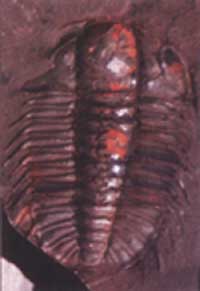 This
is a Tribolit fossil. Tribolit has emerged at the beginning of
the Cambrian Period just like many other organisms. It has a
framework of eyes just like today’s insects. Then, how did
these eyes of the animal 500 million years ago? Evolutionists
can not answer this question. There has never been found one
form that may belong to the ancestor of Tribolit, or any other
organism that may have lived during the Cambrian Period.
This
is a Tribolit fossil. Tribolit has emerged at the beginning of
the Cambrian Period just like many other organisms. It has a
framework of eyes just like today’s insects. Then, how did
these eyes of the animal 500 million years ago? Evolutionists
can not answer this question. There has never been found one
form that may belong to the ancestor of Tribolit, or any other
organism that may have lived during the Cambrian Period. 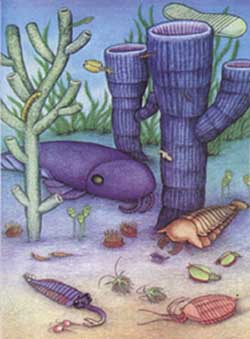
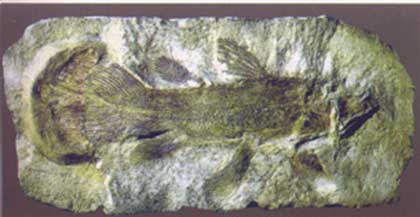 Coelacanth was assumed to be a transitional form, representing
the transition from water to land. The discovery of living
samples of the fish alleged to be 300 million years old,
actually shocked the evolutionists.
Coelacanth was assumed to be a transitional form, representing
the transition from water to land. The discovery of living
samples of the fish alleged to be 300 million years old,
actually shocked the evolutionists. 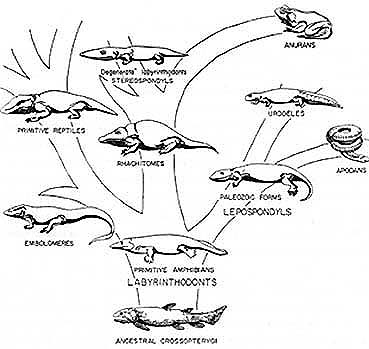 Above, you may see the evolution story of the transition of a
fish similar to Coelacanth, to land creatures. This diagram, is
totally a result of speculations. The sudden change from a fish
to a land dwelling creature could not be explained neither by
fossils nor theoretically.
Above, you may see the evolution story of the transition of a
fish similar to Coelacanth, to land creatures. This diagram, is
totally a result of speculations. The sudden change from a fish
to a land dwelling creature could not be explained neither by
fossils nor theoretically. 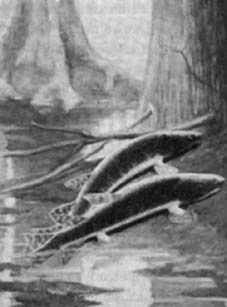 According
to the imaginary story of transition from water to land, some
fish felt the necessity to move on to land because of scarce
food sources. Of course, there is no evidence to prove this
assertion. Eventually, this theory with no factual base to
depend on, can only be presented with speculative illustrations
like the one above.
According
to the imaginary story of transition from water to land, some
fish felt the necessity to move on to land because of scarce
food sources. Of course, there is no evidence to prove this
assertion. Eventually, this theory with no factual base to
depend on, can only be presented with speculative illustrations
like the one above.  Until
1938, the fish species called Coelacanth was only known from
its fossil records. Evolutionists argued by referring to this
fossil that it was a transitional form representing animals
passing over to land from water. However, when several samples
of this fish were found one by one by researchers, it provided a
good case showing how far the evolutionists could go in their
speculations. As a result, it was clearly understood that
Coelacanth was a living fish species. So, it was taken out of
all evolutionary books in a hurry..
Until
1938, the fish species called Coelacanth was only known from
its fossil records. Evolutionists argued by referring to this
fossil that it was a transitional form representing animals
passing over to land from water. However, when several samples
of this fish were found one by one by researchers, it provided a
good case showing how far the evolutionists could go in their
speculations. As a result, it was clearly understood that
Coelacanth was a living fish species. So, it was taken out of
all evolutionary books in a hurry..  FAIRY TALES FOR GROWN UPS:
FAIRY TALES FOR GROWN UPS: 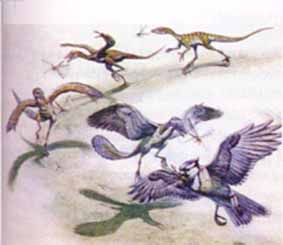 The drawings based on the speculations made on
the origins of flying. These hypothesis are in no way supported
by the findings in the fossil records.
The drawings based on the speculations made on
the origins of flying. These hypothesis are in no way supported
by the findings in the fossil records.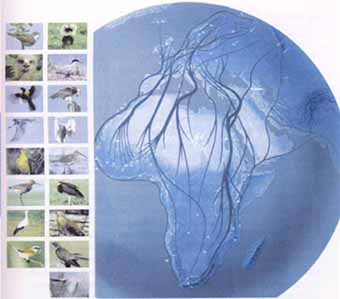
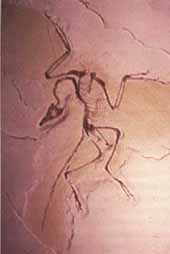 When
Archaeopteryx was found at the beginning of this
century, it was presented by the evolutionists as the
evidence of kinship between dinosaurs and the birds.
When
Archaeopteryx was found at the beginning of this
century, it was presented by the evolutionists as the
evidence of kinship between dinosaurs and the birds.
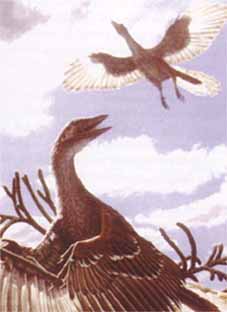 Archaeopteryx whose reconstruction is seen on the left side
is a flying bird although it has some differences from the birds
of our day.
Archaeopteryx whose reconstruction is seen on the left side
is a flying bird although it has some differences from the birds
of our day. 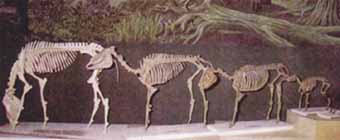 The horse series display found in a museum. These types of
series are made up by the arbitrary arrangement of various
animals which have lived in different geographies, in different
ages with a biased point of view. Here the main purpose is to
convince people who are not so knowledgeable about the subject.
The horse series display found in a museum. These types of
series are made up by the arbitrary arrangement of various
animals which have lived in different geographies, in different
ages with a biased point of view. Here the main purpose is to
convince people who are not so knowledgeable about the subject.